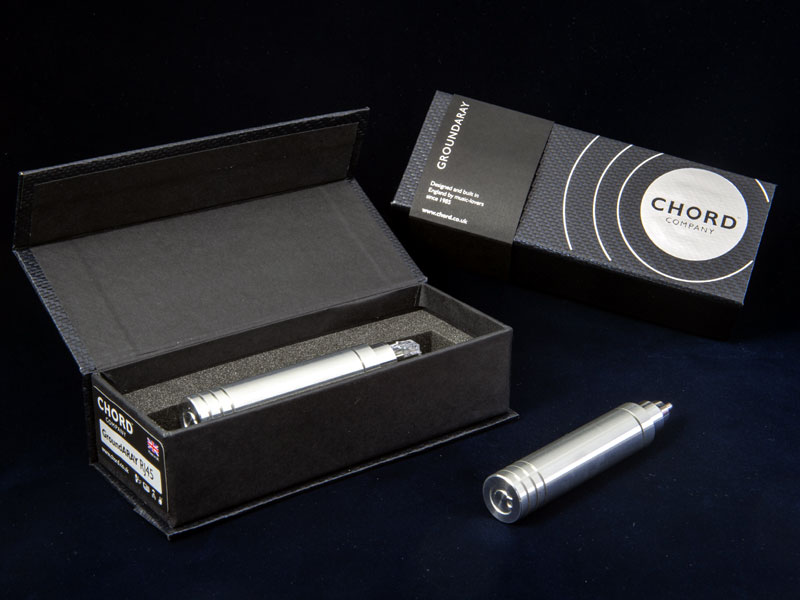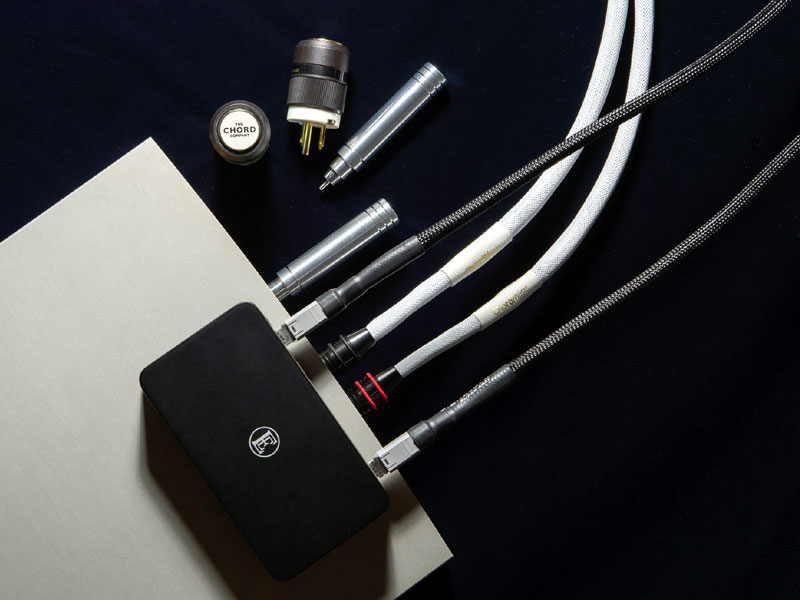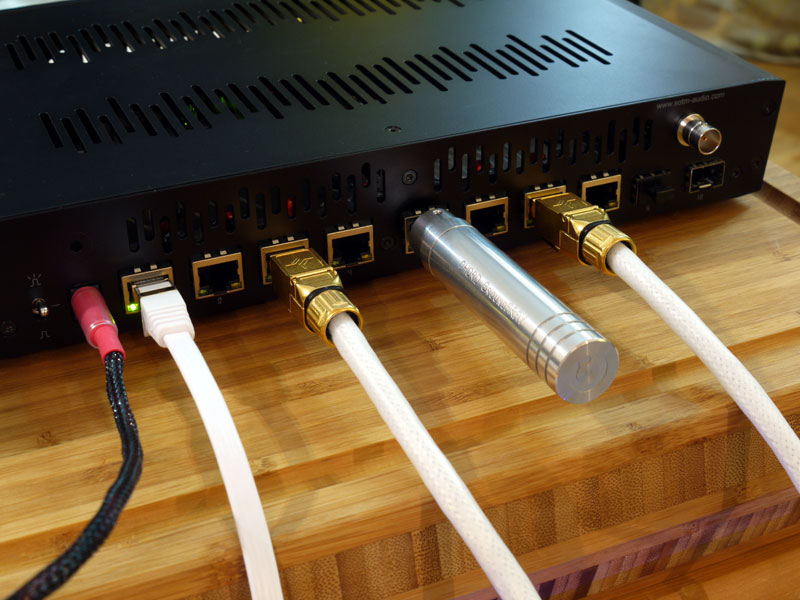First Sounds: Chord Company GroundARAY
f parallel grounding solutions have become the latest hot new product category, the offerings so far follow a familiar, almost cookie-cutter pattern. It doesn’t matter whether you are talking about the CAD Ground Controls, Nordost’s Qkore, the Entreq, or the Tripoint products, the deal is pretty much the same: a box full of some material designed to dissipate spurious noise on the signal ground, and a bunch of wires to connect it to different bits of the system. What’s in the various boxes? Manufacturers are understandably coy, but rumor suggests that the contents vary from, at one extreme, a mix of sand, wood-ash/carbon and iron filings, and, at the other, a wad of the radar-absorbent fabric found in the wings of stealth fighters and Predator drones. But contents aside, the other thing that all of these products have in common is that they are universally, demonstrably effective. I’ve been using various iterations of the approach from several different sources for a few years. In all that time, they’ve never failed to produce a significant benefit in any of the systems I’ve connected them -- and that’s a pretty wide range of equipment, generally used in environments that have already had considerable attention paid to the quality of their AC ground. Going out in public (at a hi-fi show, for instance) the benefits are even more obvious -- even if the resulting set of boxes and wires does nothing to tidy the space down the back of your rack.
But there’s a new kid on the grounding block and while it might not be big, it is seriously clever. Meet the Chord Company GroundARAY, a device that’s as neat as it is petite, but, best of all, a price of $795 means that, unlike the alternatives, it is available in bite-sized budgetary chunks. In theoretical terms this is no different to those other offerings mentioned above, a device that offers a ready sink for high-frequency noise sitting on the signal ground. It’s the implementation that makes it so different, versatile and interesting. Housed in a slim, cylindrical alloy tube, each GroundARAY is roughly the same size as a blunt-nosed, elongated XLR plug. But the beautifully finished casework and svelte proportions make it look like something that would be more at home on a high-zoot cosmetics counter than in the average audio store. The business end is graced with a plug nose -- and this is the clever bit. Available fitted with RCA, XLR (male or female) or DIN (four- and five-pin versions, for Naim owners), the connections get interesting once you enter the digital realm, with BNC, USB A, HDMI and (wait for it) RJ45 options. One of the reasons that all of these ground-related products work so well is the increasing number of switch-mode power supplies, digital and wireless devices, not just in our systems but throughout our homes -- a situation that has gotten significantly worse since the advent of file replay, with its reliance on noise-agnostic computer-industry hardware. What sets the GroundARAY apart from the crowd is that it’s designed to be applied directly at the noise source (rather than attached remotely via a wire), plugged straight into an unused socket on whatever component you choose. The advantages that accrue from eliminating that cable connection, both as a source of increased ground impedance and a possible aerial for further induced noise, help overcome the GroundARAY’s inevitably limited capacity. But more importantly, the direct-input approach makes the GroundARAY a natural for targeted intervention and significantly broadens its appeal and application. What should you hear if you stick a GroundARAY into your system’s rear? How much should you hear, given the diminutive dimensions, and where should you start? In one sense, it doesn’t matter which unit in your system you go for first, as they’re all going to demonstrate a significant benefit. But there’s no escaping the fact that digital devices seem more susceptible to (and more prone to generating) ground noise than analog circuits. So with that in mind, when it comes time to dip a toe in the GroundARAY experience, I’d start with connecting it to an unused digital input or output on your DAC or CD player. Once you do, you are going to hear the expected drop in the noise floor, expressed as increased focus, transparency and a more explicit soundstage, an increase in instrumental color and a reduction in overall grain. The placement of notes and timing improve as a result of that extra clarity, and that increases musical atmosphere and presence. Working with my CEC TL-2N transport, the subtle drum patterns on "Alison" (from Elvis Costello’s My Aim Is True [Universal 1741478]) step back in the soundstage but gain a crisp clarity and measured weight that anchor the song and the slightly ethereal guitar, while Barbirolli’s beautifully judged tempi in his RPO/Sibelius 2 [Testament SBT 1418] become even more explicit and effective, his deftly scaled dynamics building with now inexorable momentum. These are not small differences, but the best news is that they are only the tip of the iceberg. Adding a second GroundARAY, this time to the AES/EBU input on the Wadax Pre 1 Ultimate DAC, and the benefits were both reinforced and extended, with a further increase in air and texture, especially on the RPO basses. There’s more shape to those guitar notes on "Alison" and they hang more delicately in space.
In fact, the more GroundARAY’s you add, the better things get. I had a range of different options to try and ended up applying the Chord units to the digital outputs/inputs as described, along with the two unused RCA inputs on the VTL S-200 amp (you ideally need two GroundARAYs, one for each channel of a dual-mono device, and they worked with greater authority here than on the outputs of the TL-5.5 preamp). Of course, by now, with four units in play, the accumulated cost has reached the same level as a CAD GC1. So which is better? The short answer is, they’re different. The CAD delivers a more planted and anchored sound, the GroundARAYs greater transparency, detail and clarity. But the really interesting thing is when you use the CAD and the Chord units together, where their qualities dovetail perfectly, meaning that adding a GC1 to a GroundARAY solution (or vice versa) will deliver further real and significant benefits. This is what makes the GroundARAY so interesting for those already sold on parallel grounding, opening up as it does, the opportunity for further, targeted and cost-effective upgrades, which brings me to perhaps the best example of exactly that. Anybody running files as a serious source is likely doing it via a dedicated audio network, probably built around a high-quality switch. I use a SOtM sNH-10G, with its matching sPS-500 linear power supply. Even so, inserting an RJ45-equipped GroundARAY into an unused socket on the switch didn’t just snap high-res files into focus; it brought a welcome sense of stability and presence to the replay, significantly narrowing the normally all-too-obvious gap to physical media. For all computer audiophiles out there, this is a must-try upgrade. If you are running a dedicated router, too, I can only imagine the benefits. By the very nature of the beast, results will vary a little with different equipment and different situations, demanding a degree of experimentation, but then that’s half the fun. While our travel options remain limited and we’re all spending more time at home, the GroundARAY is the perfect way to scratch that audio itch. Its diminutive dimensions and direct-input implementation make it the perfect mail-order upgrade to play with in the comfort of your own system. And when you’ve sorted out the audio, there’s always the TV. The impact of the HDMI terminated GroundARAY on my Sony LCD’s picture quality was, frankly, startling -- and if there’s an easier demo than that, I haven’t seen (or heard) it. Just make sure that the miserly space allocations for the (often recessed) sockets on the average TV will allow you to insert the GroundARAY.
In a perfect example of the law of unintended consequences, a pre-production GroundARAY, sent out for distributor feedback, found its way to a highly influential Japanese magazine, which didn’t just review it -- they gave it a Product of The Year award. Chord has spent the last six months trying to catch up with demand from a single market -- which has rather delayed the global rollout. But, as you read this, stocks should be landing in the US shortly, if they’re not already there. Contact your dealer or The Sound Organisation to get in line. Whether you are new to system grounding or want to take
your existing solution even further, the Chord GroundARAY is pretty much the perfect way
to go. |



